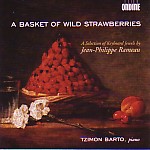When playing Rameau, Tzimon Barto pares the keyboard writing’s decorative surface down to its melodic essence, downplays its dance roots, and basically uses the text as a springboard to set off his self-proclaimed palette of “36 dynamic colors between ppp and fff”. Pianistically, Barto’s Rameau is as drop-dead gorgeous as Ondine’s engineering. Musically, it’s impossibly studied, arch, and effete. Barto seemingly cannot leave one measure of music alone without indulging in attention-getting dynamic dips, oh-so-precious breath pauses, peek-a-boo accents, mooned-over legatos, and staccato notes clipped so short that they hiccup.
He stretches out the introduction of the A minor Prelude from the 1706 Premier Livre to the point where the notes barely relate to one another, while the Gigues are so fussed over that they defy you to dance. Barto’s push-me-pull-you rhythm in the familiar Tambourin evokes a drum major who’s had two too many. In other words, Barto makes Liberace sound like Leonhardt! Alexandre Tharaud, Angela Hewitt, and, best of all, Marcelle Meyer proved how you can make a stylish, beautiful, and pianistically viable case for this repertoire. In Barto’s mannered hands, the wild strawberries referred to in this collection’s title have spoiled.
































